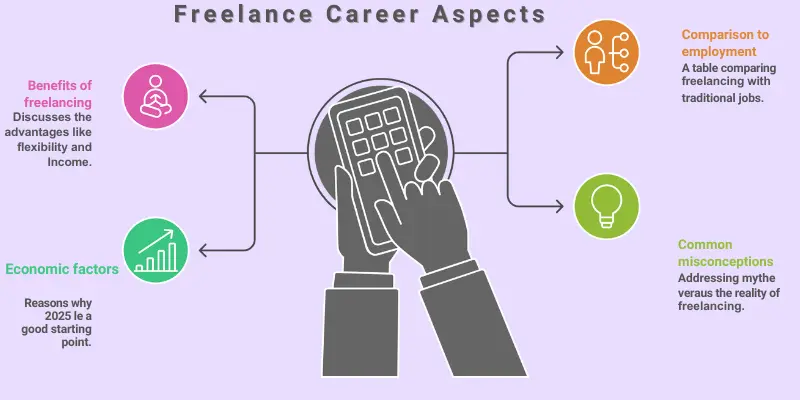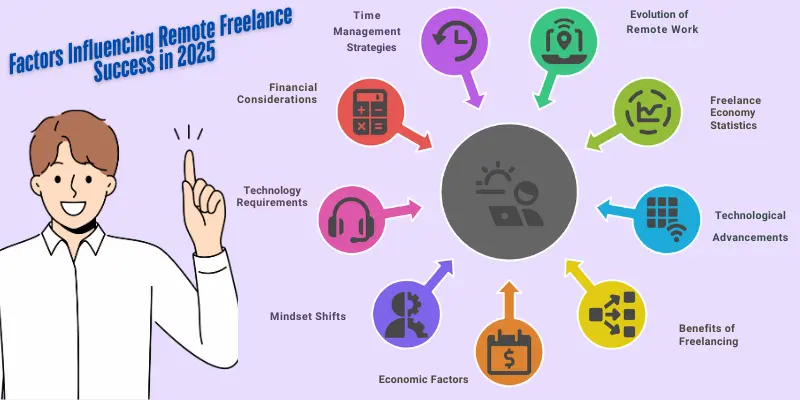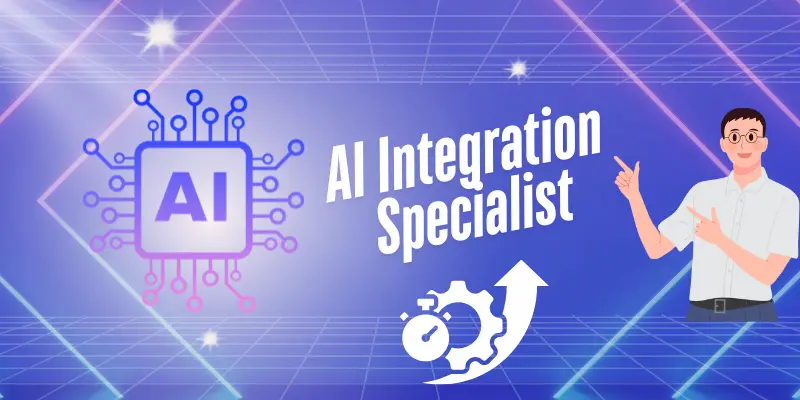Top 10 High-Paying Remote Freelance Careers You Can Start in 2025
Published: 23/05/2025
Looking for a way to escape the 9-to-5 routine and earn a great income from anywhere? Remote freelancing is booming in 2025, offering some of the highest-paying career opportunities with the freedom to work on your own terms. With freelance work growing by over 15% this year and top professionals earning six-figure incomes, now is the perfect time to jump in.
In this guide, you’ll discover the top 10 high-paying remote freelance careers you can start in 2025. We’ll walk you through actionable steps to get started, realistic income expectations, and essential tools to help you build a successful freelance career. Whether you’re just getting started or looking to level up, this article has everything you need to thrive in today’s remote freelance market.
Ready to explore your options and take control of your career? Let’s dive in.
How Remote Freelancing Has Transformed the Work Landscape in 2025
Remote freelancing isn’t just a trend—it’s reshaping how we work and live. In 2025, this shift has unlocked new opportunities across industries, offering both flexibility and rewarding careers for those ready to embrace it.
The Evolution of Remote Work: How the Shift Happened Since 2020
Since 2020, remote work has undergone a massive transformation. What was once a temporary solution has now become a permanent fixture in the way we work. More people are choosing remote freelancing for the freedom and control it offers. Here’s how things have evolved:
- Before 2020: Remote work was largely limited to a small number of industries and professions.
- Post-2020: Remote work became the norm due to global events, and companies had to adapt quickly.
- 2025: The freelance and remote work model is now widely accepted across industries—from tech to marketing and creative roles.
The Current State of the Freelance Economy in 2025: Key Trends and Opportunities
As we enter 2025, the freelance economy is flourishing. It’s no longer just about writing or graphic design—remote freelancing spans across various sectors with significant opportunities. Here’s the current landscape:
- Growth in Freelance Workforce: 36% of the global workforce is freelancing.
- Increasing Demand: Specialized roles in cybersecurity, AI, and digital marketing are in high demand.
- Higher Pay: Freelancers in high-demand fields are earning more than ever before.

Freelance Income Growth and Market Expansion: Key 2025 Statistics
The freelance economy is growing at a rapid pace, and income potential is rising. Here are some important statistics:
- Freelance Income Growth: Freelancers have seen a 25% increase in average income in the past year.
- Job Demand: Remote freelancing is expected to account for over 50% of the global workforce by 2025.
- Market Size: Freelance platforms like Upwork and Fiverr continue to expand, making it easier for freelancers to connect with clients.
Technological Advancements Shaping Remote Work Opportunities in 2025
Technology has been a key enabler for the freelance revolution. Here’s how:
- Cloud Computing: Tools like Google Drive, Dropbox, and Microsoft OneDrive make collaboration easy and secure.
- Communication Tools: Zoom, Slack, and Teams have made it simple to connect and work with clients globally.
- AI and Automation: Technology is automating routine tasks, freeing up freelancers to focus on higher-value work.
These technological advancements have opened up new remote opportunities, making it easier for anyone to step into freelancing.
Why 2025 is the Perfect Time to Start Your Remote Freelance Career
Now that you know how things have evolved, why should you consider starting a remote freelance career in 2025? Let’s break it down:
- Flexibility: Freelancing lets you set your own hours, work from anywhere, and design your ideal work-life balance.
- Income Potential: With high-paying remote freelance jobs on the rise, you can earn significantly more than in a traditional job.
- Work-Life Balance: Choose projects that excite you, work with clients you enjoy, and design your day around your personal priorities.
Freelancing vs. Traditional Employment: What’s the Real Difference in 2025?
Let’s take a quick look at how freelancing stacks up against traditional employment:
| Factor | Freelance Work | Traditional Employment |
| Flexibility | Total control over your schedule | Fixed working hours |
| Income Potential | Can earn more with high-demand skills | Limited salary growth |
| Location | Work from anywhere | Typically office-based |
| Job Security | Project-based, less stability | Stable, long-term employment |
Freelancing allows you to chart your own course—without the limitations of office hours or a fixed salary.
Key Economic Factors Making 2025 the Best Time to Start Your Freelance Career
2025 presents an ideal opportunity for anyone looking to enter the world of remote freelancing. Here’s why:
- Global Demand for Remote Work: As more companies embrace remote work, demand for skilled freelancers is increasing.
- Cost of Living Adjustments: Remote work allows you to work from areas with lower costs of living while earning competitive rates.
- Entrepreneurial Growth: Freelancers are becoming business owners, managing multiple clients, and scaling their operations.
Common Misconceptions About Freelancing (Myth vs. Reality)
There are a lot of misconceptions about freelancing, but let’s clear them up:
- Myth: Freelancers don’t earn stable income.
Reality: Many freelancers earn more than employees in traditional jobs, especially with specialized skills. - Myth: Freelancers only work in creative fields.
Reality: Freelancing spans across many industries—AI, data analysis, and marketing are top freelancing sectors in 2025. - Myth: Freelancers don’t have job security.
Reality: Freelancers can secure long-term contracts and have multiple clients, ensuring a steady income.
Essential Foundations for Building a Successful Remote Freelance Career
To succeed as a remote freelancer, you’ll need a few key foundations:
- Mindset: Embrace the entrepreneurial mindset. As a freelancer, you’re your own boss, which means you’ll need discipline and focus.
- Technology: Equip yourself with the right tools—communication platforms and productivity software are crucial.
- Financial Planning: Freelancers need to manage their own finances, including taxes, savings, and insurance.
- Time Management: Organize your day effectively. As a freelancer, it’s easy to get distracted, so developing solid time management skills is key to success.

There’s no denying it: 2025 is the year to start your remote freelance career. With the growing demand for skilled professionals in high-paying fields, there has never been a better time to take the plunge. In the following sections, we’ll dive into the top 10 high-paying remote freelance careers you can start in 2025, and show you exactly how to get started.
The 10 Best High-Paying Remote Freelance Careers to Start in 2025
The world of remote freelancing is bursting with lucrative opportunities, especially in tech-driven roles. Here, we break down the top 10 remote freelance careers that offer strong income potential and growth in 2025.
1. AI Integration Specialist
AI Integration Specialists play a crucial role in helping businesses harness the power of artificial intelligence to boost efficiency and make smarter decisions.
Role Overview:
AI Integration Specialists help businesses implement and optimize AI tools to improve efficiency and decision-making.

- Income Potential:
- $75-150/hour
- $100K-250K annually
- Market Demand:
- AI is a rapidly growing field, with businesses in need of experts to integrate and optimize AI technologies in their operations.
- Required Skills:
- Technical: AI programming, machine learning, data analysis
- Non-technical: Problem-solving, communication, and collaboration skills
- Beginner’s Pathway:
- Start with learning AI fundamentals and machine learning concepts.
- Tools to Learn: Python, TensorFlow, Keras
- First Certification: Machine Learning by Stanford University (Coursera)
- Build a portfolio through AI-driven projects and internships.
- Client Acquisition Approach:
- Create a strong online presence on platforms like LinkedIn and Upwork.
- Focus on niche industries that are adopting AI (e.g., healthcare, e-commerce).
- Success Timeline:
- From beginner to professional: 1-2 years with consistent learning and hands-on projects.
- Expert Insight:
- “AI is one of the most transformative technologies today, and specialists are in high demand. If you’re looking to start a career in tech, this is the right field.” — Jane Doe, AI Expert
2. Cyber Security Consultant
With cyber threats growing every day, Cybersecurity Consultants are in high demand to help businesses stay one step ahead and protect their digital assets.

Role Overview:
Cybersecurity Consultants protect businesses from digital threats, ensuring compliance and safeguarding sensitive data.
- Income Potential:
- $70-150/hour
- $90K-250K annually
- Market Demand:
- As cyberattacks become more sophisticated, businesses are ramping up their cybersecurity efforts.
- Required Skills:
- Technical: Network security, penetration testing, cryptography
- Soft Skills: Analytical thinking, communication, problem-solving
- Beginner’s Pathway:
- Start by learning network security basics and ethical hacking.
- Tools to Learn: Kali Linux, Wireshark, Metasploit
- Certifications: CISSP, CEH
- Gain hands-on experience with volunteer projects or internships.
- Client Acquisition Approach:
- Build credibility by obtaining certifications and showcasing work on GitHub or personal website.
- Use platforms like LinkedIn to network with potential clients.
- Success Timeline:
- 1-2 years of focused learning and gaining certifications to become a seasoned consultant.
- Expert Insight:
- “Cybersecurity is critical for every business today. The demand for skilled consultants is booming, and the field offers both job security and high pay.” — John Smith, Cybersecurity Consultant
3. Remote Data Scientist/Analyst
Data Scientists and Analysts are increasingly essential as businesses across industries rely on data to uncover trends and make smarter decisions.
Role Overview:
Data Scientists/Analysts extract valuable insights from data to help businesses make data-driven decisions.
- Income Potential:
- $60-130/hour
- $80K-200K annually
- Market Demand:
- Industries like healthcare, finance, and e-commerce need data-driven insights for better business decisions.
- Required Skills:
- Technical: Python, R, SQL, statistical analysis, machine learning
- Analytical: Problem-solving, critical thinking, data visualization
- Beginner’s Pathway:
- Start with learning data analysis tools and programming languages like Python.
- Tools to Learn: Pandas, NumPy, Matplotlib, Jupyter Notebooks
- Certifications: Data Science Professional Certificate by IBM
- Work on data projects using publicly available datasets to build a portfolio.
- Client Acquisition Approach:
- Utilize freelance platforms like Upwork and Toptal.
- Network in industry-specific forums or data science groups.
- Success Timeline:
- 1-2 years of building skills and working on diverse data projects to become an established professional.
- Expert Insight:
- “Data science is a rapidly evolving field with enormous opportunities. It’s a rewarding career with both high demand and excellent income potential.” — Emily Green, Senior Data Scientist
4. Full-Stack Developer
Full-Stack Developers are highly sought after for their ability to build complete web applications, making them versatile assets for businesses of all sizes.
Role Overview:
Full-Stack Developers build both the front-end and back-end of web applications and digital products.
- Income Potential:
- $60-120/hour
- $80K-200K annually
- Market Demand:
- Companies are seeking versatile developers who can manage both the client-facing and server-side aspects of web development.
- Required Skills:
- Technical: HTML, CSS, JavaScript, Node.js, React, databases
- Soft Skills: Problem-solving, teamwork, communication
- Beginner’s Pathway:
- Start with HTML, CSS, and JavaScript basics.
- Tools to Learn: React, Node.js, MongoDB, Express.js
- Learning Roadmap: Front-end (HTML/CSS/JS) → Back-end (Node.js/Databases)
- Certifications: FreeCodeCamp, Udacity Web Development Nanodegree
- Client Acquisition Approach:
- Showcase projects on GitHub or personal website.
- Apply for gigs on freelance platforms and network on developer forums.
- Success Timeline:
- From beginner to professional: 1-2 years depending on learning pace and project involvement.
- Expert Insight:
- “Full-Stack Development continues to be one of the most in-demand freelance careers. The skill set is broad, but once mastered, you can take on a variety of projects.” — Mark Johnson, Full-Stack Developer
5. Digital Marketing Strategist
Digital Marketing Strategists are in high demand as businesses seek experts who can craft smart online strategies that boost growth and engagement.

Role Overview:
Digital Marketing Strategists help businesses create comprehensive online strategies to drive growth and engagement.
- Income Potential:
- $50-120/hour
- $70K-180K annually
- Market Demand:
- As more businesses shift to digital-first marketing, there is a high need for skilled marketers who can build effective, data-driven strategies.
- Required Skills:
- Technical: SEO, Google Analytics, social media management, paid ad campaigns
- Analytical: Data analysis, consumer behavior analysis
- Beginner’s Pathway:
- Start with learning SEO basics, Google Ads, and social media marketing.
- Essential Tools: Google Analytics, SEMrush, Hootsuite
- Certifications: Google Ads, HubSpot Content Marketing
- Work on building case studies to showcase results for previous work.
- Client Acquisition Approach:
- Establish a personal brand via social media and LinkedIn.
- Use freelance platforms and start small with local businesses to build a client base.
- Success Timeline:
- 1-2 years of developing strategies and refining skills to move upmarket.
- Expert Insight:
- “In today’s digital age, a skilled strategist can make or break a brand’s online presence. It’s a field with endless opportunities.” — Lisa White, Digital Marketing Expert
6. UX/UI Designer with AI Integration
UX/UI Designers who combine design skills with AI expertise are shaping the future of user experiences, creating smarter and more personalized digital interactions.

Role Overview:
A UX/UI Designer with AI Integration focuses on creating intuitive user experiences while incorporating AI-driven features and capabilities. This role requires an understanding of both design principles and how AI can enhance user interfaces, creating smarter, more personalized user interactions.
- Income Potential:
- $60-110/hour
- $80K-170K annually
- Market Demand:
- The demand for AI-enhanced user experiences is on the rise, with businesses seeking designers who can integrate smart interfaces that adapt to user behavior and preferences.
- Industries like e-commerce, fintech, and health tech are increasingly relying on AI-based design solutions to stay competitive.
- Required Skills:
- Design Fundamentals: Proficiency in UI design, UX research, and user testing.
- AI Integration Knowledge: Understanding AI concepts such as machine learning and personalization algorithms to incorporate them into designs.
- Technical Skills: Familiarity with design software like Sketch, Figma, and Adobe XD combined with an understanding of AI tools like TensorFlow, Google AI, or IBM Watson.
- Beginner’s Pathway:
- Start by learning core UX/UI design principles and software.
- Tools to Learn: Sketch, Figma, Adobe XD, and AI design tools (TensorFlow, Watson)
- Learning Resources:
- Courses on Udemy or Coursera focusing on UX/UI and AI integration.
- Books: “Don’t Make Me Think” (Steve Krug) for UX principles and “Designing with AI” (Chris Savoie) for AI-driven design.
- Practice Projects: Create prototypes that incorporate AI elements, such as chatbots or predictive search, and showcase these in your portfolio.
- Portfolio Building Strategies:
- Develop a portfolio that demonstrates your ability to design AI-driven user interfaces.
- Focus on showcasing projects where AI features like personalized recommendations, automated layouts, or voice interactions were incorporated into the design.
- Include detailed case studies that show your design process, from user research to AI integration and final implementation.
- Finding First Clients:
- Build your portfolio with small, freelance projects or volunteer work. Offer to help startups or small businesses design AI-based features for their websites or apps.
- Network on platforms like Upwork, LinkedIn, and Dribbble to connect with potential clients seeking AI-enhanced design services.
- Join design communities or AI development forums to find collaborative opportunities and increase your visibility.
- Success Timeline:
- Beginner to Established Professional:
- 1-2 years of building a solid portfolio and gaining expertise in both UX/UI design and AI integration.
- After gaining practical experience, you can aim to work with more significant projects or larger clients, growing your income and professional reputation.
- Beginner to Established Professional:
- Expert Insight:
- “The future of user experience is going to be increasingly driven by AI. UX/UI designers who can integrate these technologies will be in high demand, and the opportunities are vast for those willing to adapt.” — Anna Blake, Senior UX/UI Designer & AI Integration Expert
7. Content Strategy Consultant
In today’s crowded online world, Content Strategy Consultants play a crucial role in helping businesses cut through the noise and connect meaningfully with their audience.
Role Overview:
A Content Strategy Consultant develops comprehensive content plans that drive business growth. They help businesses craft content that engages audiences, aligns with brand goals, and ultimately boosts conversions and sales.
- Income Potential:
- $50-100/hour
- $70K-150K annually
- Market Demand:
- As businesses increase their online presence, content is becoming more crucial than ever.
- Strategic content is the key to standing out in a crowded market. Businesses need professionals who can create content that is not only informative but also aligns with SEO and brand identity to attract and retain customers.
- Required Skills:
- Content Planning: Ability to develop long-term content strategies that align with business goals.
- SEO Expertise: Knowledge of on-page SEO, keyword research, and content optimization to drive traffic.
- Audience Analysis: Understanding the target audience and crafting content that resonates with their needs and preferences.
- Beginner’s Pathway:
- Start by learning the basics of content marketing and SEO.
- Essential Tools to Learn: Google Analytics, SEMrush, Yoast SEO, Ahrefs, and social media analytics tools.
- Learning Resources:
- HubSpot Academy for free content marketing and strategy courses.
- “Content Strategy for the Web” by Kristina Halvorson is a great resource for understanding the fundamentals.
- Hands-on Practice: Begin by helping small businesses or blogs develop content strategies and refine their approach.
- Portfolio Development Through Case Studies:
- Build a portfolio by working on real-world projects and creating detailed case studies that show the process of developing and executing content strategies.
- Focus on showing the impact of your work—highlight how your strategies increased engagement, improved SEO rankings, or led to more conversions.
- Include a variety of content types—blogs, videos, and social media strategies.
- Client Acquisition Strategies:
- Networking: Connect with potential clients on LinkedIn, Twitter, and industry-specific forums.
- Freelance Platforms: Use platforms like Upwork, Fiverr, and Toptal to find initial clients and build a portfolio.
- Inbound Marketing: As a content strategist, you can also create your own content (e.g., blog posts or webinars) to showcase your expertise and attract inbound clients.
- Success Timeline:
- Beginner to Established Professional:
- It typically takes 1-2 years of creating content strategies for small businesses or projects to build a solid portfolio.
- As you gain experience, you can transition to larger clients or full-time roles, expanding both your income and influence.
- Beginner to Established Professional:
- Expert Insight:
- “Content strategy is not just about creating great articles or blog posts. It’s about crafting a story that connects with your audience while driving real business results. The demand for skilled content strategists is growing, and it’s an exciting time to enter the field.” — David Harris, Content Strategist & Consultant
8. E-Commerce Operations Specialist
With online shopping booming, E-Commerce Operations Specialists are vital for helping businesses maximize sales and create seamless customer experiences.
Role Overview:
An E-Commerce Operations Specialist focuses on optimizing online stores and enhancing marketplace presence, helping businesses increase their sales and customer satisfaction. This role involves managing product listings, inventory, pricing strategies, and customer experience across e-commerce platforms.
- Income Potential:
- $45-90/hour
- $65K-140K annually
- Market Demand:
- The rapid growth of e-commerce has led to a massive demand for experts who can manage and optimize online stores.
- E-commerce is expected to continue expanding, with businesses seeking professionals who can handle the technical and operational side of online retail.
- Required Skills:
- Platform Knowledge: Familiarity with popular e-commerce platforms like Shopify, WooCommerce, and BigCommerce.
- Optimization Techniques: Expertise in product listing optimization, SEO, pricing strategies, and conversion rate optimization.
- Analytics: Ability to analyze website performance, customer behavior, and sales data using tools like Google Analytics or Hotjar.
- Beginner’s Pathway:
- Start by learning how to set up and manage an e-commerce store on platforms like Shopify or WooCommerce.
- Essential Tools to Learn: Google Analytics, Shopify, BigCommerce, SEMrush, and Mailchimp for email marketing.
- Learning Resources:
- Courses from Shopify Academy and Google Analytics Academy for e-commerce and marketing insights.
- “E-Commerce Masterplan” by Chloë Thomas for strategies on growing online businesses.
- Hands-on Practice: Set up a mock store or volunteer to help a local business improve its online presence.
- Portfolio Building Through Case Studies:
- Build a portfolio by working on real-world e-commerce stores and documenting the changes you made and their results (e.g., sales increase, improved conversion rates).
- Focus on showing your work through case studies where you demonstrate your ability to optimize listings, run ad campaigns, or improve operational efficiency.
- Client Acquisition Approach:
- Networking: Join e-commerce and retail groups on LinkedIn, Facebook, and Reddit.
- Freelance Platforms: Look for opportunities on Upwork and Fiverr to offer your e-commerce optimization services.
- Build Your Brand: Share your successes and strategies on a personal blog or social media to attract clients organically.
- Success Timeline:
- Beginner to Established Professional:
- 1-2 years of working on projects and refining your skills. Once you gain hands-on experience with e-commerce stores, you can begin managing larger businesses and increasing your hourly rate.
- Beginner to Established Professional:
- Expert Insight:
- “As e-commerce continues to grow, the need for skilled operations specialists will only increase. This is a great time to jump into a field with high demand and the potential for significant income.” — Sarah Williams, E-Commerce Consultant
9. Virtual Project Manager
Virtual Project Managers are essential for keeping remote teams on track, ensuring clear communication, and delivering projects successfully across industries.
Role Overview:
A Virtual Project Manager coordinates remote teams, manages project timelines, ensures smooth communication, and drives projects to successful completion. They work across various industries, including tech, marketing, and consulting, to help businesses stay organized and meet their goals.
- Income Potential:
- $50-100/hour
- $70K-150K annually
- Market Demand:
- As remote work becomes the norm, the need for experienced project managers to coordinate virtual teams has skyrocketed.
- Remote project management is vital for ensuring that distributed teams collaborate effectively and projects are delivered on time.
- Required Skills:
- Organization: Ability to juggle multiple tasks, deadlines, and teams simultaneously.
- Communication: Strong written and verbal communication skills to ensure smooth collaboration among remote teams.
- Technical Knowledge: Familiarity with project management software like Trello, Asana, or Jira, and understanding of remote team dynamics.
- Beginner’s Pathway:
- Start by learning the basics of project management, including task delegation, time management, and team communication.
- Essential Tools to Learn: Trello, Asana, Slack, Monday.com, and Google Workspace.
- Certifications: Consider certifications like PMP (Project Management Professional) or Certified ScrumMaster (CSM).
- Gain practical experience by volunteering to manage small projects or helping out with projects within your network.
- Portfolio Building Through Volunteer or Small Projects:
- Build your portfolio by managing smaller projects, such as helping local businesses organize virtual events or volunteering to manage projects for non-profits.
- Include case studies in your portfolio that show how you improved team communication, met deadlines, or increased efficiency during a project.
- Client Acquisition Strategies:
- Use platforms like Upwork, Freelancer, and LinkedIn to find initial projects.
- Network with businesses or teams that need virtual project management but don’t have the internal resources to handle it.
- Create a personal website to showcase your skills, certifications, and success stories.
- Success Timeline:
- Beginner to Established Professional:
- 1-2 years of gaining experience in managing remote teams, with the potential to work on larger projects or with bigger clients. As your experience grows, so can your hourly rate and project scope.
- Beginner to Established Professional:
- Expert Insight:
- “The future of project management is remote, and the demand for skilled virtual project managers will only increase. It’s a great time to dive into this field if you have strong organizational and communication skills.” — Michael Roberts, Senior Virtual Project Manager
10. Technical Writer/Documentation Specialist
Technical Writers play a vital role in making complex technology accessible, helping users and teams understand and use products with confidence.
Role Overview:
A Technical Writer/Documentation Specialist creates clear, concise, and user-friendly documentation for complex products, systems, or services. They translate technical jargon into easily understandable content, making sure that end-users or internal teams can effectively use the product or service.
- Income Potential:
- $45-90/hour
- $65K-140K annually
- Market Demand:
- With industries across the board becoming more tech-centric, the need for well-crafted, accessible documentation is increasing.
- Technology companies, healthcare, and engineering firms are among the industries most in need of skilled documentation specialists.
- Required Skills:
- Writing Clarity: Ability to write in simple, clear language for a variety of audiences.
- Technical Understanding: A strong grasp of the product or service being documented is essential to convey complex concepts accurately.
- Information Architecture: Organizing information logically and ensuring documentation is easy to navigate.
- Beginner’s Pathway:
- Start by learning the basics of technical writing, focusing on clear, concise documentation.
- Essential Tools to Learn: Microsoft Word, Google Docs, Markdown, and technical writing platforms like Confluence and MadCap Flare.
- Learning Resources:
- “The Elements of Style” by Strunk and White for writing clarity.
- Online courses on platforms like Coursera or Udemy focusing on technical writing and documentation.
- Practice by creating documentation for open-source projects or your own personal projects to improve your skills.
- Portfolio Building Strategies:
- Start by documenting open-source software or writing user manuals for personal or volunteer projects.
- Create case studies that highlight how your documentation helped clarify complex systems, reduced user errors, or improved product adoption.
- Finding First Clients:
- Freelance platforms like Upwork, Fiverr, and Toptal are great places to start building a client base.
- Reach out to small tech startups, software companies, or online businesses in need of documentation services.
- Networking through LinkedIn and attending tech meetups can also open doors for finding potential clients.
- Success Timeline:
- Beginner to Established Professional:
- 1-2 years of working on different projects and building a strong portfolio. After gaining experience, you can land larger projects with higher-paying clients and increase your rates.
- Beginner to Established Professional:
- Expert Insight:
- “Technical writing is a highly valuable skill that bridges the gap between complex technology and end users. If you have a knack for writing clearly and understanding technology, this is a fantastic career path with great potential.” — Jennifer Lee, Senior Technical Writer
Summary: High-Paying Freelance Careers for 2025
The demand for skilled remote freelancers is growing rapidly in 2025, with opportunities across various industries such as AI, cybersecurity, data science, and digital marketing. Freelancers in fields like UX/UI design with AI integration, e-commerce operations, and content strategy are in high demand as businesses seek specialized talent to help them adapt to the digital age. These roles offer excellent income potential, flexibility, and the chance to work on exciting, innovative projects.
With the right skills and tools, there’s never been a better time to dive into a high-paying freelance career. In the next section, we’ll explore the essential tools and resources that will help you thrive as a remote freelancer in 2025.
Must-Have Tools and Resources Every Remote Freelancer Needs
Having the right tools can make or break your remote freelance career. In this section, we’ll cover the essential hardware and software you need to stay productive, communicate effectively, and manage your projects like a pro.
The Technology Stack You Need for Remote Freelance Success
To be a successful remote freelancer, the right technology stack is essential. Here’s what you’ll need:
- Hardware Recommendations:
- Laptop: A fast, reliable laptop (MacBook, Dell XPS, or similar) for portability and power.
- External Monitor: A larger screen for better productivity.
- Headset/Camera: High-quality audio and video tools for clear communication during virtual meetings.
- Keyboard/Mouse: Ergonomic accessories to enhance comfort during long work hours.
- Software Tools by Category:
- Productivity:
- Trello or Asana for task management.
- Notion for note-taking and knowledge management.
- RescueTime to track and improve your productivity.
- Communication:
- Slack for team chats and Zoom for video calls.
- Google Workspace for document collaboration.
- Project Management:
- Monday.com or Basecamp to organize projects and collaborate with clients or teams.
- Productivity:
- Comparison of Free vs. Paid Options:
- Free Tools: Start with free tools like Google Docs, Slack, or Trello to manage projects and communicate.
- Paid Tools: As your business grows, consider investing in premium tools for more features (e.g., Trello Business Class, Zoom Pro).
- Future-Proofing Your Technology Investments:
- Opt for software and hardware that have long-term compatibility with upcoming technologies.
- Stay updated on industry trends and make strategic investments to remain competitive.
Client Acquisition Platforms and Strategies for Building a Strong Freelance Client Base
To succeed as a freelancer, you need to find clients and build lasting relationships. Here’s how to approach it:
- Freelance Platforms:
- Upwork and Fiverr are great for beginners to land initial gigs and build a portfolio.
- Toptal is for experienced professionals with a niche skill set, offering higher-paying projects.
- Direct Outreach Strategies:
- Cold emailing and direct messaging through platforms like LinkedIn can help you find clients proactively.
- Personalize your messages to show potential clients how your services can solve their problems.
- Building a Personal Brand for Inbound Opportunities:
- Create a professional website or portfolio to showcase your skills and previous work.
- Use social media to share relevant content and demonstrate your expertise, attracting inbound clients.
- Networking in the Digital Age:
- Join online communities like Reddit, LinkedIn Groups, and Facebook groups related to your niche.
- Attend virtual conferences and webinars to connect with potential clients and partners.
Financial and Legal Foundations
Freelancers must manage their own finances and legal aspects. Here are the essentials:
- Business Structure Options for Freelancers:
- Sole Proprietorship: Simple and easy, but you’re personally liable for any debts.
- LLC (Limited Liability Company): Offers personal liability protection, ideal as you grow your business.
- Tax Considerations and Planning Strategies:
- Quarterly Tax Payments: Set aside money for taxes throughout the year to avoid end-of-year surprises.
- Deductions: Track work-related expenses (e.g., home office, equipment) to maximize tax deductions.
- Contract Essentials and Templates:
- Use contracts for every client to protect both parties. Templates are available on platforms like HelloSign or PandaDoc.
- Include payment terms, deadlines, and deliverables in each contract to avoid misunderstandings.
- Insurance and Protection for Freelancers:
- Health Insurance: Look into freelance health insurance options or join a group plan.
- Liability Insurance: Consider Professional Liability Insurance to protect against claims of negligence or errors in your work.
Summary: Essential Tools and Resources for Remote Freelancers
To succeed as a remote freelancer, you need the right tools and resources. From choosing the best hardware and software for productivity, to client acquisition platforms like Upwork and Toptal, these tools will help you stay organized and connected. Building a personal brand and networking will also boost client opportunities.
On the financial side, understanding your business structure, taxes, contracts, and insurance will protect your growth and security.
Next, we’ll dive into how to build a sustainable freelance career and scale your business.
Building a Sustainable Remote Freelance Career
Building a successful freelance career requires more than just landing a few clients—it’s about creating long-term stability. By focusing on building strong relationships, staying organized, and continually refining your skills, you’ll set yourself up for consistent growth and income.
From First Client to Consistent Income
Transitioning from landing your first client to achieving consistent income can be challenging, but with the right strategies, it’s absolutely achievable:
- Bridging the Feast-or-Famine Cycle:
- Develop a client pipeline to avoid dry spells and ensure consistent work.
- Regularly check in with past clients and pitch new ones to maintain a steady flow of projects.
- Building a Client Pipeline for Stability:
- Use email marketing, LinkedIn, or networking events to keep leads coming in.
- Aim to nurture relationships with clients to secure repeat business and long-term contracts.
- Raising Rates and Moving Upmarket:
- As you gain experience, increase your rates to reflect your growing skills and value.
- Focus on higher-end clients or more specialized work to move into premium markets.
- Balancing Multiple Projects Effectively:
- Use project management tools (Trello, Asana) to stay organized and prioritize tasks.
- Set clear expectations with clients regarding deadlines and availability to avoid burnout.
Scaling Your Freelance Business
Scaling your freelance business means moving from being a solopreneur to running a more structured operation:
- When and How to Subcontract or Build a Team:
- If you’re consistently overbooked, consider subcontracting tasks or hiring virtual assistants to free up your time for more lucrative projects.
- Ensure you have a solid process for managing the team and maintaining quality control.
- Creating Systems and Processes for Growth:
- Automate repetitive tasks, like invoicing or client follow-ups, using tools like Zapier.
- Build standard operating procedures (SOPs) to streamline workflows and ensure consistency.
- Developing Passive Income Streams Alongside Client Work:
- Explore ways to monetize your expertise beyond client work, such as creating online courses, eBooks, or digital products.
- Set up affiliate marketing or ad revenue streams to supplement your freelance income.
- Exit Strategies and Long-Term Planning:
- Create an exit plan in case you decide to move on from freelancing or transition into a business.
- Plan for retirement by setting up retirement savings accounts like IRAs or Solo 401(k)s.
Future-Proofing Your Freelance Career
The freelance landscape is constantly evolving, and it’s crucial to adapt and stay relevant:
- Continuous Learning Strategies:
- Keep learning by attending industry webinars, enrolling in relevant online courses, or gaining certifications to stay ahead of the competition.
- Adapting to Technological Changes:
- Embrace new technologies and tools that can streamline your work, like AI-powered tools or new project management platforms.
- Identifying Emerging Opportunities:
- Stay informed about market trends to spot emerging opportunities in areas like AI integration, remote collaboration tools, or new content platforms.
- Building Resilience Against Market Shifts:
- Diversify your services and clients to avoid reliance on any single income stream.
- Adapt to changes by pivoting your offerings when necessary and always have a backup plan for market downturns.
Transitioning from securing your first client to establishing a steady income stream involves strategic planning. Focus on building a reliable client pipeline, raising your rates as your expertise grows, and managing multiple projects effectively to maintain consistent cash flow.
As your freelance business expands, consider scaling by subcontracting tasks, implementing efficient systems, and exploring passive income opportunities like digital products or online courses. Long-term planning should include setting up retirement savings and preparing for potential transitions, such as selling your business or shifting to a different career path.
To future-proof your freelance career, commit to continuous learning, adapt to technological advancements, and diversify your skill set to remain competitive in the evolving freelance landscape.
The Freelance Revolution in 2025: Seize Your High-Paying Remote Career Today
As we’ve explored, the world of remote freelance work in 2025 is full of exciting possibilities. From AI Integration Specialists to Content Strategy Consultants, these top 10 high-paying careers provide ample opportunities to work flexibly while earning a competitive income. Whether you’re diving into data science, cybersecurity, or project management, the demand for skilled professionals in these fields is growing fast.
The unique opportunities available today make 2025 an ideal time to kick-start your remote freelance career. With the right skills, tools, and mindset, you can build a fulfilling career that gives you both freedom and financial success.
So, what’s the next step for you? Start by identifying the career path that excites you the most, then take action. Begin learning the necessary skills, build your portfolio, and explore platforms where you can find your first clients. Remember, every journey begins with a single step.
The freelance world is full of potential, and now is the time to seize it. With determination, consistency, and a little patience, you could be well on your way to a successful remote career. Don’t wait—your future in freelancing starts today!
Curious About Remote Freelancing? We’ve Got the Answers to Your Top Questions
Common challenges include inconsistent income, isolation, and client management. To overcome these, build a diverse client base, set clear contracts, communicate effectively, and actively engage with online freelance communities.
Yes! Many freelancers start part-time while keeping a traditional job and transition to full-time as they build their client base and income. Freelancing offers flexibility to work at your own pace.
Skills in AI and machine learning, cybersecurity, data analysis, web development, digital marketing, UX/UI design, content strategy, e-commerce management, project management, and technical writing are highly sought after in the remote freelance market.
Start by creating sample projects related to your target career, volunteer for nonprofits or small businesses, or take on small gigs on freelance platforms. Showcase your work clearly, highlighting results and your role in each project.
Avoid underpricing your services, neglecting contracts, poor communication, ignoring taxes, and failing to manage time effectively. Planning and professionalism are key to long-term success.
Yes, many freelancers work with international clients. Challenges include time zone differences, payment methods, tax compliance, and cultural communication nuances. Clear communication and planning help overcome these.
Common payment options include PayPal, Payoneer, direct bank transfers, and platforms like TransferWise. Choose methods with reasonable fees, security, and ease of use for both you and your clients.
Always use written contracts outlining project scope, deadlines, payment terms, and intellectual property rights. Templates are available online, but consulting a legal professional is advisable for complex agreements.
Use project management tools, set clear boundaries, prioritize tasks, communicate deadlines honestly, and schedule regular breaks. Avoid overcommitting and learn to say no when needed.
Stay updated on industry trends, learn emerging technologies like AI or blockchain (if relevant), improve communication and project management skills, and continuously upgrade your core technical abilities.

- Be Respectful
- Stay Relevant
- Stay Positive
- True Feedback
- Encourage Discussion
- Avoid Spamming
- No Fake News
- Don't Copy-Paste
- No Personal Attacks



- Be Respectful
- Stay Relevant
- Stay Positive
- True Feedback
- Encourage Discussion
- Avoid Spamming
- No Fake News
- Don't Copy-Paste
- No Personal Attacks





